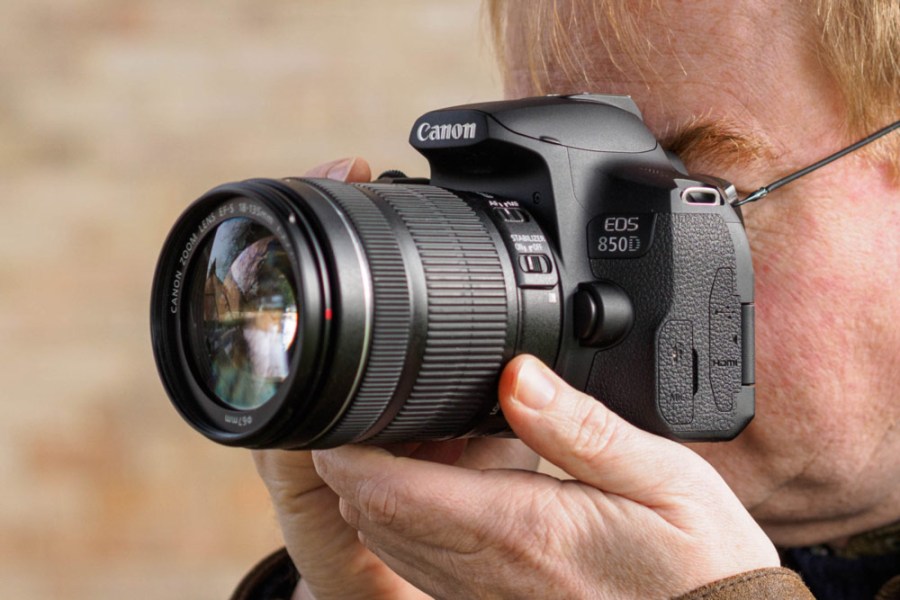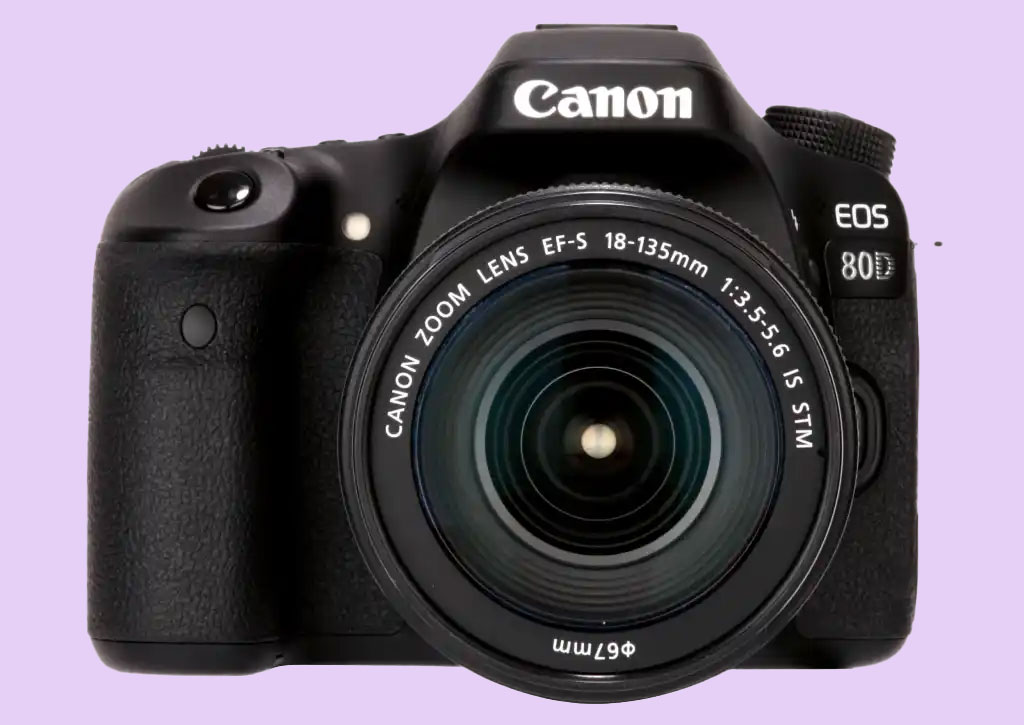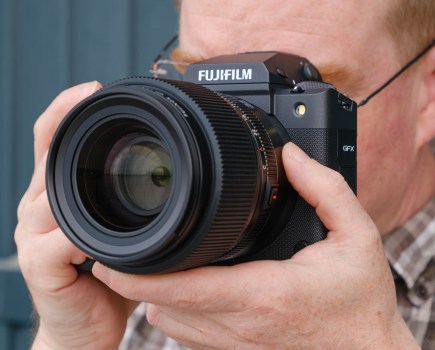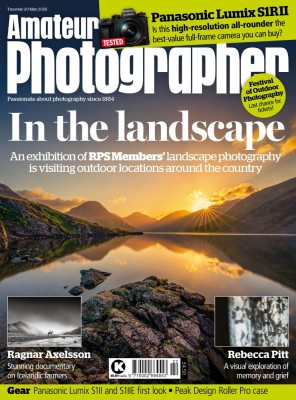The best Canon DSLRs remain among the most popular cameras ever made – and it’s easy to see why. With so many cameras for beginners, enthusiasts and professionals alike, Canon’s EOS DSLR range offers an abundance of capable, durable cameras that reliably capture great-looking imagery. Then there’s the lenses – as a DSLR user, you have absolutely loads of top EF-mount lenses to choose from, with cheap models aplenty on the used market.
The modern day value in buying a DSLR is because it is no longer the premium camera format. These days, manufacturers focus on their mirrorless cameras, which is where the latest and best camera tech occurs – and Canon’s own EOS R mirrorless line is gaining traction. Entry-level mirrorless like the Canon EOS R50 and Canon EOS R100, aimed at beginners, prove that Canon wants new photographers to embrace the newer system. Learn about the differences between the two types in our DSLR vs mirrorless guide.
You can learn more about how to pick a Canon DSLR at the bottom of this page in our explainer and FAQ section. For now, read on to discover the best Canon DSLRs we’ve ever reviewed and tested…
There’s a Canon DSLR for everyone
We’ve picked out what we think are the best Canon DSLR cameras for all budgets and abilities. We’ve started with new cameras first, and then added a few of the best second-hand classics. So let’s jump in with a quick run-down:
- Best Canon DSLR for sports and wildlife: Canon EOS 90D – buy now
- Best budget full-frame Canon DSLR: Canon EOS 6D Mark II – buy now
- Best Canon DSLR for travel: Rebel SL3 / Canon EOS 250D – buy now
- Best cheap Canon DSLR: Rebel T100 / Canon EOS 4000D – buy now
- Best Canon DSLR for beginners: Rebel T7 / Canon EOS 2000D – buy now
- Best Canon DSLR for enthusiasts: Rebel T8i / Canon EOS 850D – buy now
- Best professional Canon DSLR all around: Canon EOS 5D Mark IV – buy now
- Best professional Canon DSLR for sports and action: Canon EOS-1D X Mark III – buy now
And here are our picks for the best Canon DSLRs to buy used:
- Best used Canon DSLR for beginners: EOS Rebel T5 / Canon EOS 1200D – buy now
- Best used Canon DSLR for enthusiasts: Canon EOS 80D – buy now
- Best used Canon DSLR for action and sports photography: Canon EOS 7D Mark II – buy now
- Best used Canon DSLR for video: Canon EOS 5D Mark III – buy now
- Best used full-frame Canon DSLR: Canon EOS 6D – buy now
Continue reading to find out why these DSLRs are so highly rated…
Best Canon DSLR for sports and wildlife
Canon EOS 90D
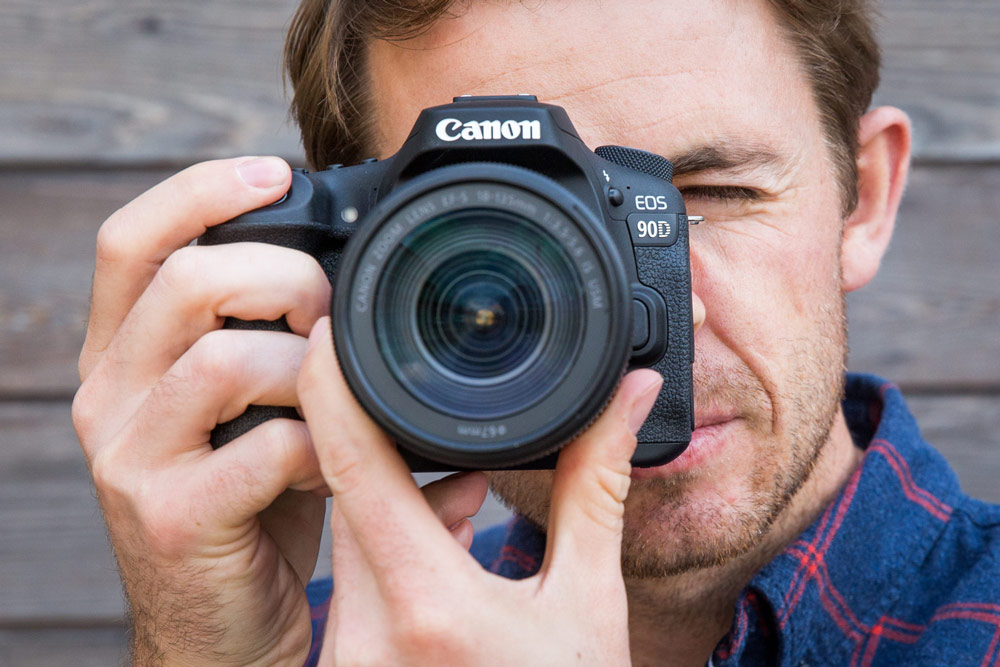
Amateur Photographer verdict
A worthy swansong for Canon’s enthusiast DSLRs, the 32.5MP Canon EOS 90D blends speed, portability and versatility. Make it a priority to upgrade from the lacklustre kit zoom and you’ll sorted.- High pixel count
- Dual Pixel AF in Live View
- 10fps shooting
- Solid build
- No USB charging
- Viewfinder AF inferior to Live View
At a glance
- $999 / £1,300 body only
- 32.5MP APS-C sensor
- 45 cross-type AF points
- 10fps shooting speed
- ISO100-12,800, expandable to 25,600
- 4K 29.95/25p video
The Canon EOS 90D is Canon’s highest resolution APS-C format camera, with a 32.5MP sensor: perfect for making big prints of your best shots. Shoot raws and you’ll achieve images packed with close detail, good dynamic range and lifelike colours. For a faster workflow, out-of-camera JPEGs are excellent, too.
The camera’s high resolution facilitates big prints. The freedom to crop into pictures and pull out small details with minimal sacrifice to image quality make it well suited to fine-art photography and macro photography. Together with the 1.6x crop factor, this also makes it a great camera for wildlife photography.
Made for the enthusiast
The EOS 90D is a fine stills camera and, with a monitor that swivels to face forward, also suits prospective vloggers. Shooting 4K video also comes without any crop, plus there are headphone and microphone sockets. In fact the EOS 90D is a great all round camera for enthusiasts, boasting high speed continuous shooting capability too. Its closest rival in Canon’s mirrorless range is the Canon EOS R7, but that has far less lens choice, unless you don’t mind using Canon EF-S DSLR lenses via an adaptor – in which case you may do better sticking with a Canon DSLR in the first place.
Read our full Canon EOS 90D review
Best budget full frame Canon DSLR
Canon EOS 6D Mark II
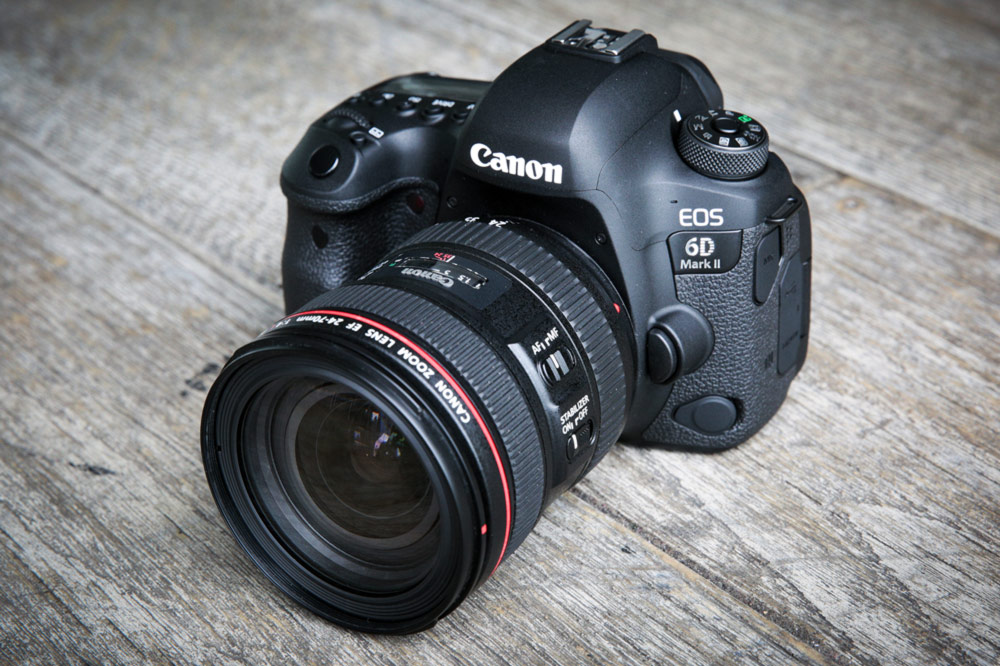
Amateur Photographer verdict
One of the more affordable routes into full-frame, the Canon EOS 6D Mark II is a snappy, adaptable performer. Its AF speed is decent, if showing its age, and the low-light performance is impressive.- Full-frame 26.1MP sensor
- Vari-angle touchscreen
- Fast shooting
- In-camera RAW processing
- One SD card slot
- Viewfinder AF array quite small
At a glance
- $1,200 / £1,430 body only. Around $700 / £750 used
- 26.2 megapixel full-frame sensor
- ISO 100-40,000
- Dual Pixel AF
- Built-in GPS
- 45 cross type AF points
The Canon EOS 6D Mark II is the cheapest full frame DSLR in the Canon line-up; yet is a long way from being a basic model. It’s actually very well featured for the money, thanks to its 26.2MP resolution, 45 AF phase detect points and 7560 RGB+IR metering sensor.
In Live View shooting you also get very competent AF performance, thanks to Canon’s Dual Pixel AF that covers over 80% of the image area and gives speedy and accurate autofocusing in stills and video. It’ll also work well in challenging conditions such as low light in night photography. Using the EOS 6D Mark II in live view mode offers many of the advantages of mirrorless cameras, showing that the DSLR design still has a few tricks up its sleeve.
Intuitive control layout
Using the optical viewfinder, you get a 6.5fps maximum shooting speed with AE/AF tracking – just the ticket for subjects on the move. Handling and ergonomics rate highly, with a typically generous collection of controls, including a focus joystick and rear control dial plus a fully articulating 3-inch touchscreen. Its body is weather-sealed, too.
Read our full Canon EOS 6D Mark II review
Best Canon DSLR for travel
Rebel SL3 / Canon EOS 250D
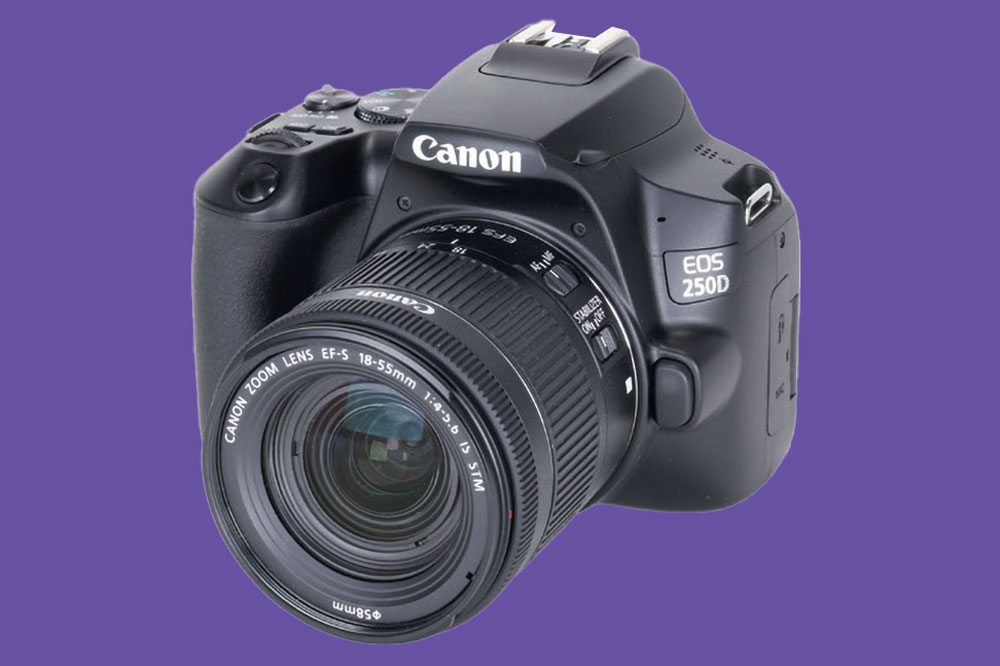
Amateur Photographer verdict
This entry-level DSLR is ideal for students, with helpful guide modes that’ll mean you get the most out of its APS-C sensor. It may be a little basic for some, but it’s a solid starter camera.- Articulating monitor
- Canon’s Dual Pixel AF
- 4K movies
- Impressive shot capacity in viewfinder shooting
- Small viewfinder
- 4K video comes with 1.7x crop
- No Dual Pixel AF in video mode
At a glance
- $749 / £769 with 18-55mm IS STM lens
- 24.1MP APS-C sensor
- Dual Pixel AF
- Shoots at 5fps
- Articulating monitor
- 4K movies
The Canon Rebel SL3 / EOS 250D is one of the smallest DSLRs you can get, yet accommodates a good set of features, and even a fully-articulated vari-angle rear screen. Suitable for beginner and student photographers with its simple user-friendly guide mode, it is powerful enough to continue to serve them as they explore more advanced techniques. Its compact stature makes it good for travel, and with a touch-sensitive vari-angle monitor that can face forwards, it’s perfect for vlogging and selfies, food photography, and more. Video shooters can enjoy 4K UHD video recording for crystal clear movies.
Shoot over 1000 frames from a single charge
Of course, it is a very capable performer for stills with its the 24MP sensor and Canon’s Dual Pixel autofocusing, which give consistently pin-sharp results in stills and video; even in poor light. Battery life is extremely good too, with a claimed 1070 shots using the optical finder – another advantage of the DSLR design.
Read our Canon EOS 250D / Rebel SL3 Review
Best cheap Canon DSLR
Rebel T100 / Canon EOS 4000D
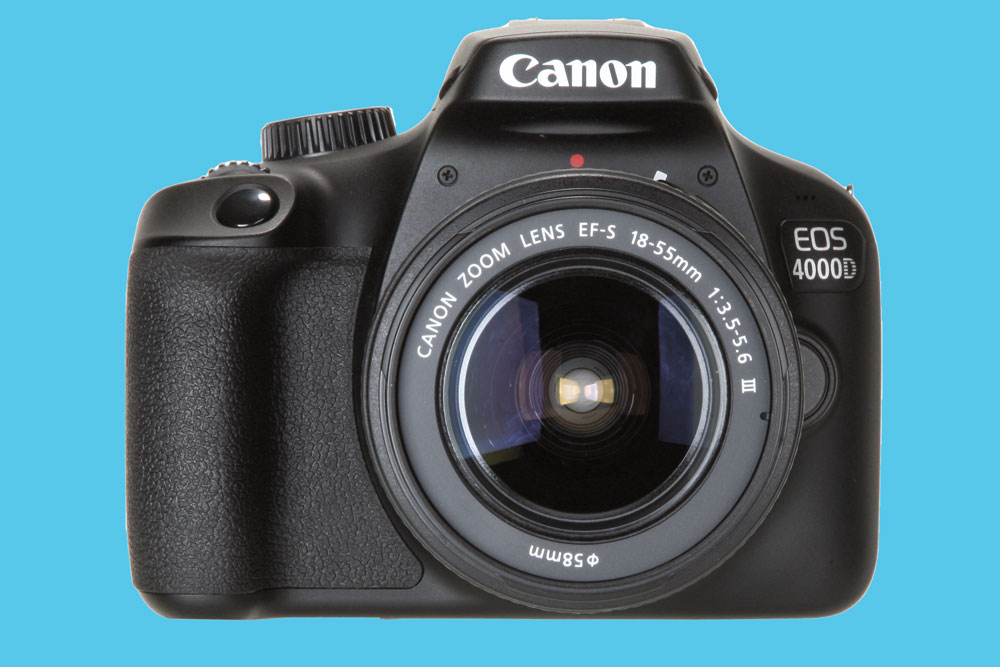
Amateur Photographer verdict
A no-fuss camera to be sure. It may be too stripped-down for some, but if you’re looking for an ultra-cheap Canon DSLR, this is the cheapest on the menu.- Compact, lightweight
- Great value
- Integrated flash
- Only 18MP
- Nine AF points
- Full HD video only (no 4K)
- Small rear monitor
At a glance
- $379 / £360 with 18-55mm lens, around $200 / £160 (excellent used condition) body only
- 18 megapixel APS-C sensor
- Nine autofocus points
- 3fps shooting speed
- 63-zone dual layer exposure meter
This is Canon’s least expensive DSLR, and it is certainly built down to a price, but it is still fairly well furnished with features. It should suit no fuss point-and-shoot snapping for photography students and beginners who desire a ‘proper’ camera without breaking the bank. Users who want to take it out of full auto mode will find reliably accurate focusing and exposure systems at their disposal. Impressively, considering this price level, the EOS 4000D has a 63-zone dual layer exposure meter that delivers great results in a range of lighting conditions, and while the AF system is limited to nine points, it works well and responsively.
A good starting point
The Rebel T100 / EOS 4000D has an 18MP APS-C sensor with resolution good enough for most uses. It is an old design, however, and keen photographers may feel the urge to upgrade before long. It has a native ISO speed range of 100 to 6400, which is pretty modest by today’s standards, but there is a pop-up flash for shooting in low light.
Read our Canon EOS 4000D review
Best Canon DSLR for beginners
Rebel T7 / Canon EOS 2000D
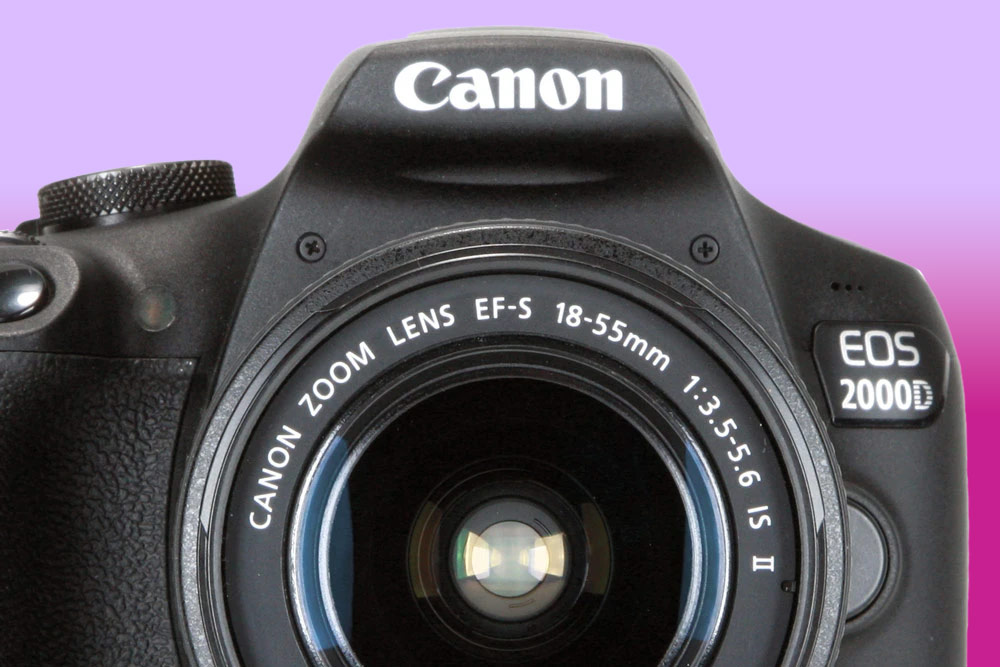
Amateur Photographer verdict
A budget camera with a little more going on than the EOS 4000D / Rebel T100, this is a basic but capable DSLR for beginners.- 24MP sensor
- Creative filters and useful feature guide
- Large, high-res monitor
- Nine AF points
- Full HD video only (no 4K)
At a glance
- $479 / £589 with 18-55mm II lens, $340 (used) / £489 body only
- 24.1MP APS-C sensor
- 9 AF points
- Creative Auto Mode and Creative filters
- 3fps shooting
- ISO 100-12800 range (extended)
The Canon Rebel T7 / EOS 2000D is still an entry-level camera, but a worthwhile step up from the Rebel T100 / EOS 4000D. A key benefit is its 24MP resolution, which is especially useful for making enlargements and prints. And speaking of bigger, the EOS 2000D’s monitor measures 7.5cm / 3inch and boasts 920,000 dots of resolution, showing off detail more effectively. This is a really practical asset for checking your images.
A more robust build quality is another benefit of the EOS 2000D over the EOS 4000D. For example, its lens mount is made of metal, rather than the engineering plastic used on the EOS 4000D.
Basic AF
The Canon Rebel T7 / EOS 2000D is unabashedly a beginner’s camera, and as such, there are a few features Canon has compromised on in order to keep the size and cost down. Its 9-point autofocus system is probably the one you’ll most immediately notice – even by beginner camera standards, this is pretty basic. For general snapshots it’ll be fine, but will struggle with fast-moving subjects.
Video-wise, the Rebel T7 / EOS 2000D shoots at a maximum resolution of Full HD 1080p, at a maximum frame rate of 30fps. If you want 4K, you’ll need to pay a little more for the Canon EOS 250D – though you do have to contend with that vicious Canon crop that plagued the firm’s 4K cameras for many years.
Read our Canon EOS 2000D / Rebel T7 review
Best Canon DSLR for enthusiasts
Rebel T8i / Canon EOS 850D
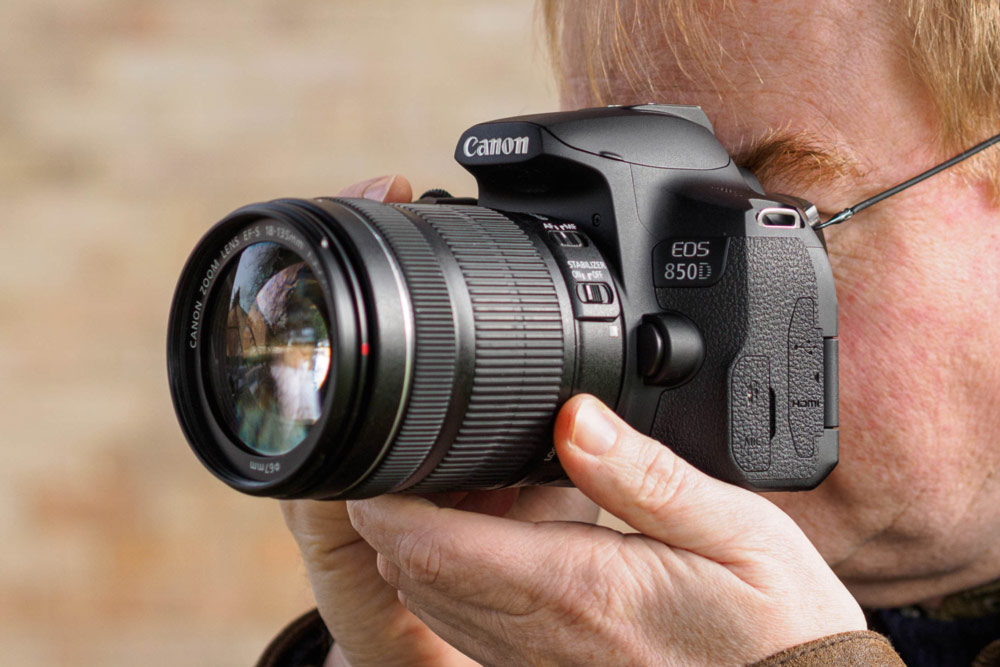
Amateur Photographer verdict
A compact and capable DSLR for enthusiasts, the EOS 850D will suit photographers who want to travel light. Its nasty 4K crop restricts its usefulness for video.- Good image quality
- Vari-angle touchscreen
- 7fps shooting with AE/AF tracking
- Body feels robust
- Small optical viewfinder
- Limited video features/performance
At a glance
- $895 with 18-55mm IS USM lens / £919 body only
- 24.1MP APS-C sensor
- 45 point, all cross type
- 7fps with AE/AF tracking
- 4K /25p video
The Canon EOS 850D has been around for a while but is still a terrific all-round package, and capable DSLR with which enthusiast photographers can expand their creative horizons. Buy it with the 18-135mm USM lens, and you have compact, lightweight package with a zoom range suitable for a wide range of subject matter, from portraits and snapshots to landscape and street. Another, more affordable kit option is with the 18-55mm IS STM lens.
Powerful processor
The EOS 850D has a 24.1MP sensor paired with a Canon DIGIC 8 processor and is capable of first-class photographs full of crisp detail and rich colours. Its ISO 100-25,600 range also allows you to shoot successfully when light levels drop. There’s the option of 4K /25p video on this camera, but the usefulness is limited because the image is cropped by 64% and there’s no Dual Pixel AF available. This restricts your angle of view, and the live view autofocus is slower; though you don’t have these limitations when shooting 1920 x 1080 full HD.
Read our full review of the Canon EOS 850D
Best professional Canon DSLR all round
Canon EOS 5D Mark IV
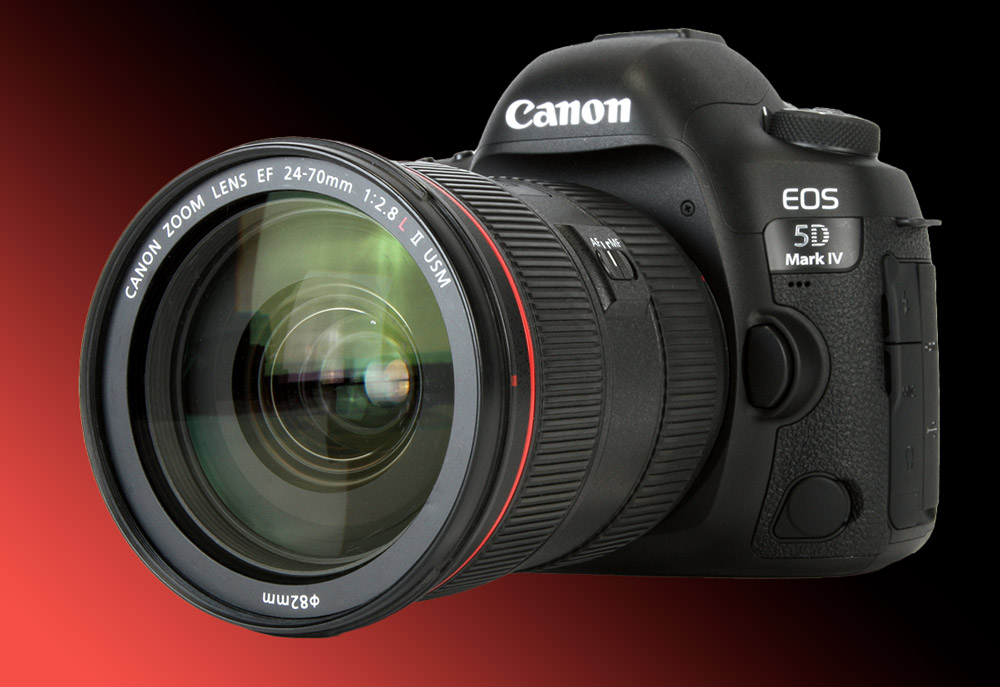
Amateur Photographer verdict
A veteran professional DSLR, the Canon EOS 5D Mark IV may look a little low-res by today’s standards, but it’s a solid performer that delivers consistently excellent imagery.- Excellent image quality
- Solid build with great handling
- Good high-ISO performance
- Dual Pixel AF with face-detect and tracking
- Fixed 3.2-inch monitor
- Slow burst rate with AF in Live View
At a glance
- $1,699 / £2,489 body only
- 30.4MP full-frame sensor
- 61 AF points
- DCI 4K 25/30p
- 150,000 pixel RGB+IR metering sensor
- DIGIC 6+ processing engine
- ISO 100-32,000
The rugged Canon EOS 5D Mark IV body has been a favourite amongst professional photographers for years, boasting advanced weather sealing and a 30.2MP full-frame sensor. The camera delivers images of outstanding clarity, colour fidelity, low noise and with excellent dynamic range giving detailed highlights and shadows. This makes it a great choice for landscape shooting, producing maximum tonality in your images. It is in fact a highly capable all-rounder that can be used for a wide range of professional and commercial subjects.
Dual Pixel Raw
Autofocus is first rate in stills and video with 61 AF points through the finder and, for shooting action, 7fps shooting with full AE/AF tracking is available. The EOS 5D Mark IV also has a neat feature called Dual Pixel RAW (DPRAW) that captures imaging data from each pixel from two very slightly different points of view. Using Canon’s free DPP software, you can edit a DPRAW image and fine-tune to adjust lighting, give a different point of focus, or adjust background bokeh. This is a somewhat technical process, and the effects are not always obvious.
Read our Canon EOS 5D Mark IV review
Best professional Canon DSLR for sports and action
Canon EOS-1D X Mark III
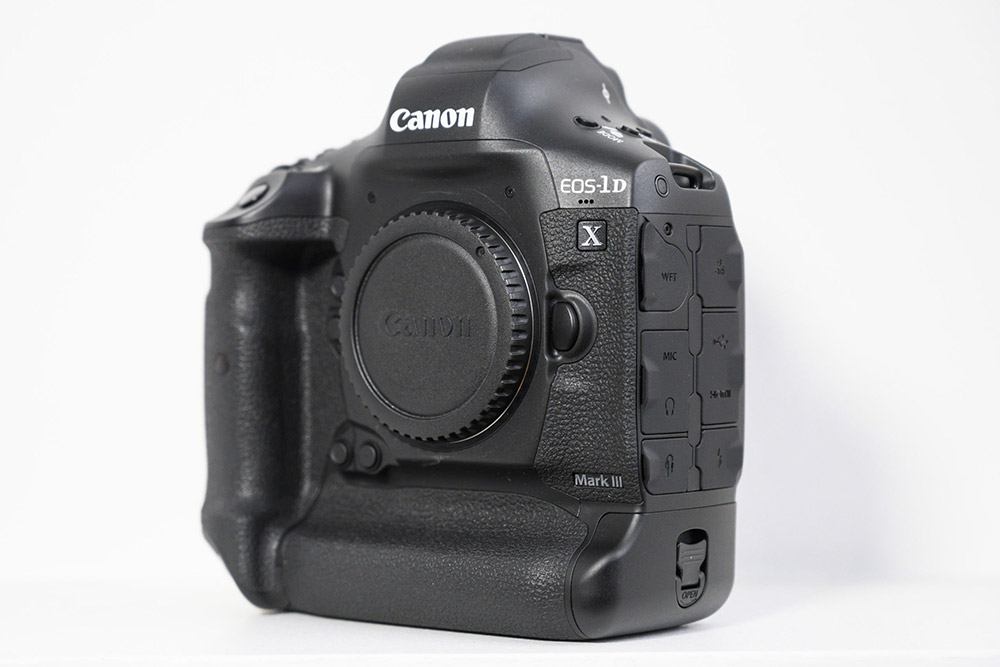
Amateur Photographer verdict
While the professional sports photography world has since moved on, this is still a thunderingly fast pro-spec camera and an absolutely superb DSLR for capturing action.- Pro-level build quality
- Large ISO range
- Fast shooting
- Takes two CFexpress Type B cards
- High asking price
- Big, heavy body
- Resolution perhaps too low for scenic/studio shooters
At a glance
- $6,499 / £6,999 body only
- 20.1MP full-frame sensor
- DIGIC X processor
- Dual Pixel AF
- 5.5K Raw video
- Huge native 100-102,400 ISO range
- 20fps max shooting speed on Live View mode
Canon’s flagship professional DSLR has an impressive feature set, including a native ISO range that peaks at 102,400. This means poor light definitely won’t stop play, which is one of the reasons why this camera has become a stalwart or professional sports and action photographers. Thanks to the advanced sensor, a special Gaussian Low Pass filter and DIGIC X processor, the image quality is remarkably good even at that high sensitivity.
High-speed shooting
Indeed, speed is the key word for this camera. You can shoot with a top speed of 16fps through the optical viewfinder, or get even more in Live View with a speed of 20fps. Perhaps even more important is that the EOS-1D X Mark III takes high-speed CFexpress Type B cards, so you can capture a lot of frames without hitting the buffer.
To cope with fast-moving action, the EOS-1D X Mark III boasts an AF system with 191 points, of which 155 are cross-type. It also has Canon’s Deep-Learning AF Algorithm that can recognise faces even when they are upside down.
The best used Canon DSLRs to buy
The second-hand market offers value for restricted budgets. Opting for a second-hand version of a camera from a few years ago is a great place to find a bargain. We recommend going with reputable dealers rather than buying privately, as you’ll get some limited warranty (usually 3-6 months) and some assurance that the camera has been checked over by professionals. With DSLRs, it’s also important to check the shutter actuations, as every camera is rated to perform to a specific number. For more, check out our guide to buying second-hand cameras.
Below, we’ve picked out a few of our favourite Canon DSLRs on the second-hand market.
Best used Canon DSLR for beginners: EOS Rebel T5 / Canon EOS 1200D
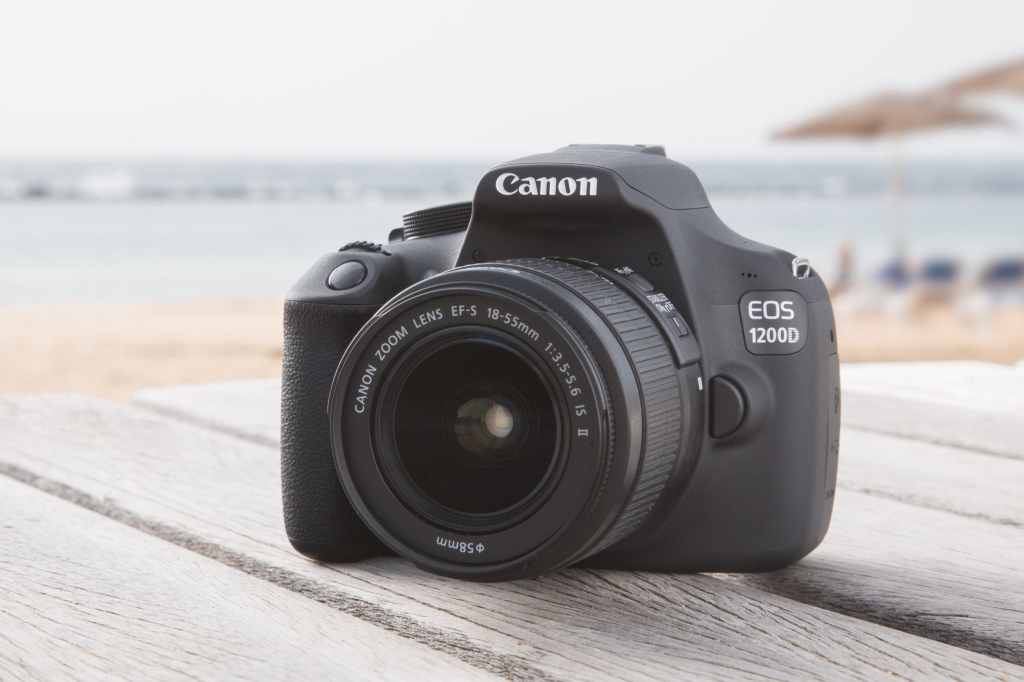
Amateur Photographer verdict
A solid beginner’s DSLR that has seen tempting price drops on the used markets, this one is well worth snapping up.- Excellent value on used market
- Reliable autofocus system
- Good high-ISO performance
- Only 3fps burst
- Only 9 AF points
At a glance:
- $265 with 18-55mm lens / £150 body only (excellent used condition)
- 18MP APS-C sensor
- DIGIC 4 processor
- ISO 100-6400 (extended to ISO 12,800)
- 3in, 460,000-dot, TFT LCD screen
Going for about a third of its original asking price on the used market, the EOS 1200D has retained a reputation as a solid, do-everything DSLR for beginners. With its 18MP APS-C sensor, it’s not quite as high-resolution as many other cameras on this list, but the autofocus system is fast and accurate in a way that punches above its weight.
Basic AF system
Once again, you only get 9 AF points, and a burst mode of 3fps – this is going to come with the territory of shopping for a beginner’s camera in 2014. This will likely be enough for most purposes, and if you need more speed than that, check out the EOS 7D Mark II below.
In our original review of the EOS 1200D, we also singled out the low-light performance as being particularly impressive. We were happy with the results we got right the way through the camera’s native ISO range of 100-6400, and that isn’t always the case with entry-level cameras. If you’re planning on urban night shoots, this is a great choice of DSLR, especially if you pick up a cheap 50mm lens to go with it.
Read our Canon EOS 1200D review
Best used Canon DSLR for enthusiasts: Canon EOS 80D
Amateur Photographer verdict
With a lovely large viewfinder and an impressive autofocus system, the EOS 80D is a capable DSLR in a host of situations. It’s also a dab hand at video – lack of 4K notwithstanding.- Accurate focusing in all modes
- Very good build quality
- Solid video spec
- Not 4K
- Single card slot
At a glance
- Around $475 / £480 (excellent used condition)
- 24.2MP APS-C CMOS sensor
- 45 cross-point AF
- ISO 100-16,000, expandable to 25,600
- 7fps shooting speed
- 100% viewfinder with 0.95x magnification
Canon’s two-digit EOS DSLRs built up a reputation for being good APS-C all-rounders, useful for photographers who want an affordable camera that does a bit of everything. The EOS 80D is an excellent example and is plentifully available second-hand. It adds a number of improvements on the previous EOS 70D, including a beefed-up autofocus system with phase-detection points across the entirety of the frame. The big optical viewfinder covering 100% of the frame is also welcome, and helps the EOS 80D deliver a marvellous shooting experience across the board.
The EOS 80D uses a relatively sophisticated autofocus system. While it cannot touch the sublime subject-detect system of cameras from the 2020s, its 45 highly accurate cross-type points are very respectable and will get the job done in most situations.
Capable for video
As it was preceded by the EOS 70D – which proved a surprising hit with YouTubers – the EOS 80D is a handily capable video camera. Having Full HD video at a frame rate of 60p is welcome, as is the vari-angle touchscreen that lets you shoot from all angles with ease. The addition of a headphone port also wins the EOS 80D a few points from videographers. It’s not 4K though, which may be a deal-breaker for some users.
Best used Canon DSLR for action and sports photography: Canon EOS 7D Mark II
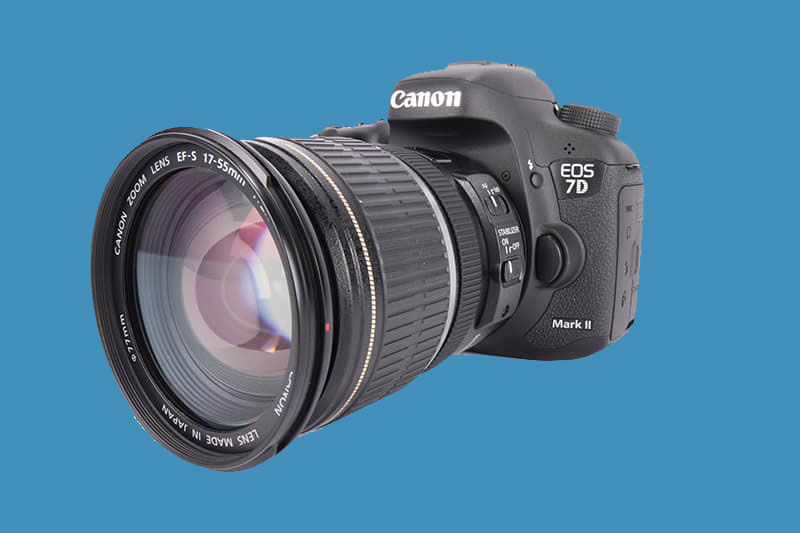
Amateur Photographer verdict
A hit budget wildlife camera, the EOS 7D Mark II has been a deservedly big hit with bird photographers. Having weather-sealing is a big plus for outdoor photography.- 10fps shooting
- Dual Pixel AF
- Dual card slots
- Weather-sealed body
- No touchscreen
- Fixed monitor
- iTR inconsistent
- No Wi-Fi
At a glance
- $680 / £575 (used, excellent condition)
- 20MP APS-C sensor
- 65 cross-point AF
- ISO 100-16,000 expandable to 51,200
- 10fps shooting speed
- Dual card slots – CompactFlash and SD
The Canon EOS 7D Mark II was introduced in 2014, a replacement for the EOS 7D that came out in 2009. Its big selling point was being an APS-C DSLR with advanced AF features derived from the EOS 5D Mark III and EOS-1D X.
As such, Canon’s renowned Dual Pixel sensor delivers good Live View AF, and 65 cross type AF points for viewfinder AF, with Intelligent Tracking and Recognition (iTR) to give improved subject tracking. The EOS 7D Mark III was the first Canon to have iTR after the EOS 1D X, and uses the RGB+ IR meter sensor to improve servo focusing with moving subjects.
Making the most of the EOS 7D Mark II’s enhanced AF skills, it can rattle along at 10fps, and when shooting raw you can get around 30 shots before buffering.
A solid build
The Canon EOS 7D Mark II has been equipped with an impressive degree of weather sealing. In the course of our testing, we took this DSLR out in “brutal weather conditions that gave it a thorough soaking” and were happily able to report that the camera came through it with no problems. If you’re an adventurous outdoor photographer, this is definitely a DSLR to consider (just make sure you also stick to weather-sealed lenses).
The EOS 7D Mark II also has two card slots, however, the camera shows its age here, as one of the slots is for the CompactFlash memory card format, which is little-used these days. You can still buy these cards from most photographic retailers; just be aware that if you upgrade from the EOS 7D Mark II to a newer camera, the CompactFlash card will almost certainly end up gathering dust in a drawer.
Read our full review of the Canon EOS 7D Mark II
Best used Canon DSLR for video: Canon EOS 5D Mark III
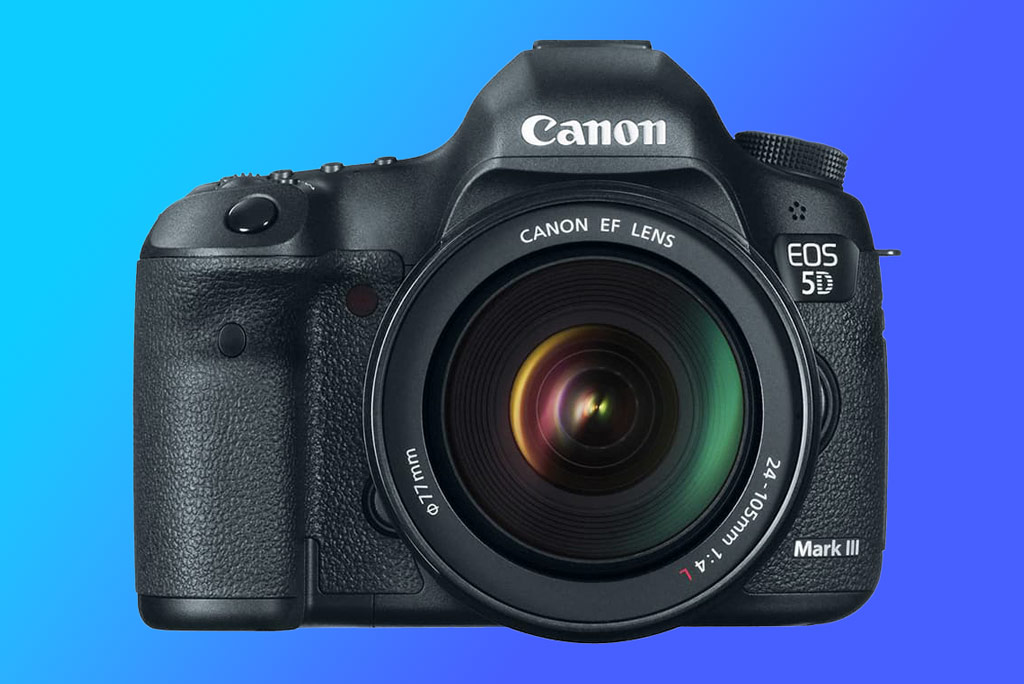
Amateur Photographer verdict
Once an expensive professional’s camera, now an incredible bargain for full-frame, the Canon EOS 5D Mark III will suit any photographer looking for all-around excellence.- Solid build
- Full HD video
- 6fps shooting
- Slow face-detect AF
- Fixed rear screen
At a glance
- $1,150 with 24-105mm lens / around £520 (Used, excellent condition)
- 22MP full-frame sensor
- 3.2in monitor
- DIGIC 5+ processor
- ISO 100-25,600
- 61AF points
- Dual CompactFlash and SD card slots
The Canon EOS 5D Mark III is an excellent full-frame camera that has proved itself a fine machine since it was introduced over ten years ago in 2012. Key features include a 22MP full-frame sensor, a 61 point AF system for speedy and accurate focusing while a 63 zone metering system ensures spot-on exposures. These days, it can be picked up second-hand for a great price.
This camera was the first Canon DSLR capable of High Dynamic Range shooting where three bracketed exposures are made and merged in-camera, and an auto align feature means you can even get perfect handheld shots. It can also shoot multiple exposures for creative effect.
The EOS 5D Mark III has a shutter rated at 150,000 actuations, so do check this aspect when shopping for a second-hand model.
Great video, but Full HD only
This camera is part of a line that basically revolutionised run-and-gun filmmaking. The EOS 5D Mark II was a genuine game-changer in terms of the quality of video output, and the EOS 5D Mark III also shoots great-quality Full HD content, and fixes a few issues with the Mark II, such as the prevalent rolling shutter. Time has marched on, of course, and many video shooters will now want 4K resolution. The EOS 5D Mark III also lacks a few features that are useful on newer cameras, such as a fully articulating screen.
Read our Canon EOS 5D Mark III review
Best used full-frame Canon DSLR: Canon EOS 6D
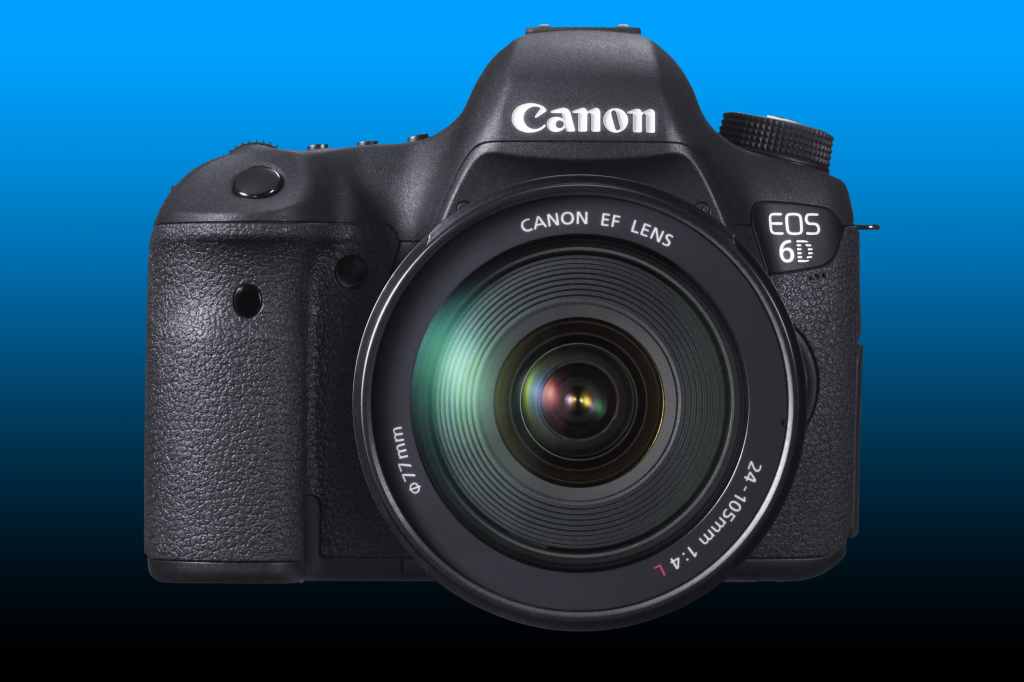
Amateur Photographer verdict
Impressive on release, the Canon EOS 6D now feels quaint. Its shooting speeds were modest even at the time, and the 20MP resolution feels low today. For used prices, however, it does offer good value.- Great price for full-frame
- Lightweight and portable
- Excellent image quality, especially in low light
- No built-in flash
- Max flash sync of 1/180sec
- Basic 11-point AF system
At a glance
- From $389 / £380 (used, excellent condition)
- 20.2MP full-frame sensor
- 4.5fps continuous shooting
- ISO 100-25,600 (exp. 50-102,800)
- 11-point AF
- In-camera HDR and multiple-exposure modes
Announced at Photokina 2012 and released a couple of months later, the EOS 6D was marketed as a smaller and more affordable alternative to the hugely popular EOS 5D Mark III. Fulfilling this brief, the 6D borrows hardware from the 5D III while also bringing some of its own to the table. For example, while the 5D III was built around a 22.3MP full-frame CMOS sensor, the 6D instead employs a 20.2MP chip. However, both cameras share the same DIGIC 5+ image processor, and both provide a native sensitivity range of ISO 100-25,600 that can be expanded to the equivalent of ISO 50-102,800.
It was released with a body-only price of $2,200/£1,680, and it’s now possible to source a second-hand 6D in ‘excellent’ condition with a shutter count less 10,000 for just a few hundred dollars/pounds. That could give you money left over to spend on an extra lens.
Magnesium alloy body
The Canon EOS 6D is very small and light for a full-frame DSLR. It’s constructed from magnesium alloy, and weighs 755g with battery and card. If you like the ergonomics of a full-frame DSLR but don’t necessarily want to carry a big, bulky system, this model could potentially strike an elegant balance that’ll suit your needs.
How to choose the best Canon DSLR
Resolution
The higher the megapixel count, the more detail the camera can capture. However, it is true that even a fairly basic camera like the Canon EOS 4000D with ‘just’ 18MP of resolution can produce professional level, detail-rich prints at A2 size and more – as long as you have a reasonably sharp lens and competent camera technique.
Autofocus
Canon DSLRs use two autofocus systems – one for the optical viewing system and another for ‘live view’ on the LCD screen, which uses Canon’s unique Dual Pixel AF, a feature introduced by Canon in 2013, first seen on the EOS 70D, and now found on most of its recent DSLRs like the EOS 90D. Each pixel on the imaging sensor is divided into two light-sensitive diodes, and they are analysed for focus data, the end result being snappy, reliable focusing in both stills and video. Dual Pixel CMOS AF is on all newer Canons and definitely worth seeking out.
APS-C vs full-frame
Canon DSLRs come with two sensor sizes – APS-C and full-frame. For many camera users, an APS-C camera is more than adequate, giving excellent image quality and is a great choice. The smaller format means physically more compact cameras and usually lower prices for both the cameras and the lenses. Full-frame cameras are preferred by dedicated enthusiasts and professional photographers. The larger format provides better image quality, with greater dynamic range and better low-light performance, but the cameras are bigger, heavier and more expensive, as are the lenses.
See our guide to APS-C vs full-frame sensors for more detail on how this all works.
Video
Canon DSLRs were at the forefront of a revolution in video in the mid-2000s. These days, a mirrorless model will serve better for video. They generally have more features, greater sophistication and better performance. The latest Canon mirrorless cameras have 4K, 4K Cine, 6K and 8K, and features like in-body image stabilisation; which Canon’s DSLRs don’t have.
That said, the enthusiast-level Canon EOS 90D is a very effective camera for shooting video. In fact, video recording is available on most Canon DSLRs, including the Canon models featured here. For serious filmmaking, you’ll likely want to get one of the best tripods for steady footage.
Canon DSLRs – frequently asked questions
Here are answers to some of the most common questions we get asked about Canon DSLRs.
Do Canon DSLRs have IBIS (in-body image stabilisation)?
No, Canon DSLRs do not have IBIS. While Canon added optical stabilisation to plenty of its EF-mount lenses, an equivalent system didn’t make its way to the camera bodies until the arrival of the mirrorless Canon EOS R5 and EOS R6.
Is Canon going to discontinue DSLRs?
We may not see any new Canon DSLRs in the future. In 2022, Canon CEO and Chairman, Fujio Mitarai, said that the Canon EOS-1D X Mark III would be Canon’s last flagship DSLR. The last new DSLR the firm announced was the Canon Rebel T8i / Canon EOS 850D in early 2020, and since then, the focus has clearly been on Canon’s mirrorless cameras. However, Canon DSLRs are still on sale and there are plenty of used examples in excellent condition and with little wear.
Can you use Canon mirrorless lenses on Canon DSLRs?
No. Canon RF mirrorless lenses cannot be adapted to work with EF-mount DSLRs. While it’s possible to adapt EF DSLR lenses to RF mirrorless cameras via Canon’s EF-EOS R adapter, there is currently no adapter that flows the other way, and there is unlikely to be one. Making such an adapter would be technologically challenging due to the RF-mount’s shorter flange distance and wider throat, and Canon has little incentive to do so when it is aiming to move photographers over to its mirrorless system.
Which Canon DSLRs are full-frame?
The Canon EOS-1Ds, EOS-1D X, EOS 5D and EOS 6D DSLRs all use full-frame sensors. All of these lines have gone through multiple iterations, with the most recent and advanced cameras being the EOS-1D X Mark III (released in 2020), the EOS 6D Mark II (from 2017) and the EOS 5D Mark IV (from 2016). Looking at older models on the second-hand market can be a great way to get full-frame quality for an affordable price, and you may have already seen we’ve put a few in this guide. Just be aware that the further back you go, the more you’ll have to compromise on features like autofocus speed, burst mode, high ISO performance and others.
Are Canon DSLRs weatherproof?
Some Canon DSLRs are weather-sealed, but not all of them. In general, the more expensive professional cameras, such as the EOS-1D X, EOS 5D and EOS 6D lines, are the ones that feature extensive weather-sealing. However, some more affordable mid-range models such as the EOS 90D also feature weatherproofing. Really, it just depends on the individual camera, so check before you buy if this is a priority feature for you.
If you’ve found the best Canon DSLR in this guide, then why not have a look at the best Canon EF-mount lenses and the best EF-mount zoom lenses to go with your new camera. Or have a look at more of our buying guides, including our look at the best Canon EOS cameras of all time (including SLRs and DSLRs), or have a look at the best Canon mirrorless cameras.
Further reading:
- What are the best value DSLRs?
- Best used DSLRs in 2025
- Second-hand DSLR lenses: ultimate buying guide

